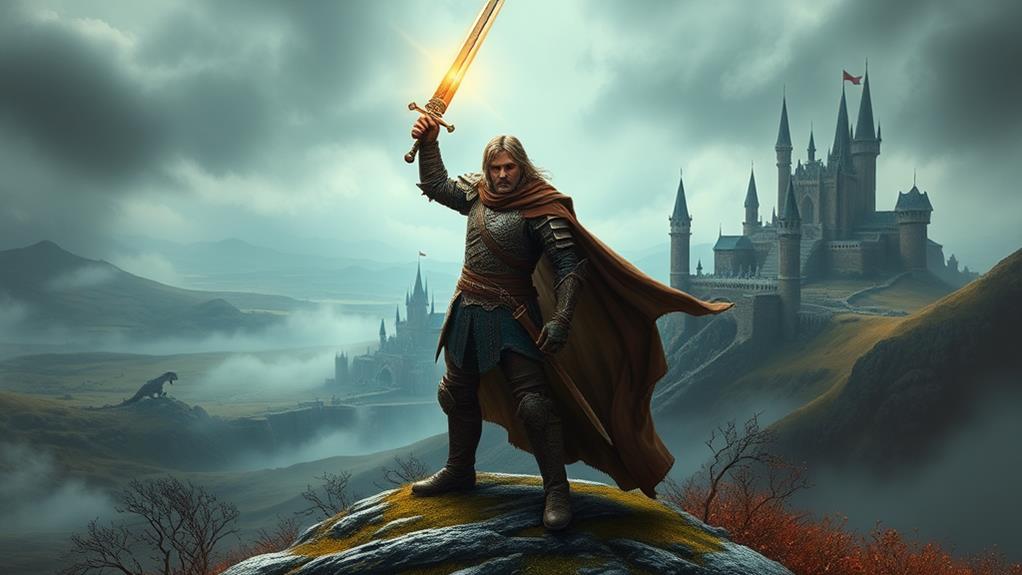
In Middle Earth, legendary conquerors wielded immense power, forging dark legacies. Sauron, with his One Ring, spread terror from Mordor, corrupting leaders and orchestrating conflicts. Morgoth, the original Dark Lord, cast shadows from his fortress Angband, igniting wars over the stolen Silmarils. Saruman's deceit and creation of the Uruk-hai led to Rohan's strife. The Witch-king, as the Nazgûl leader, instilled dread across battles, while Smaug's fiery devastation shattered Erebor's prosperity. Witness the dire impacts of ambition and tyranny on these kingdoms and the epic battles that ensued. Continue now to explore every unfolding tale of Middle Earth's darkest days.
Sauron's Dominion
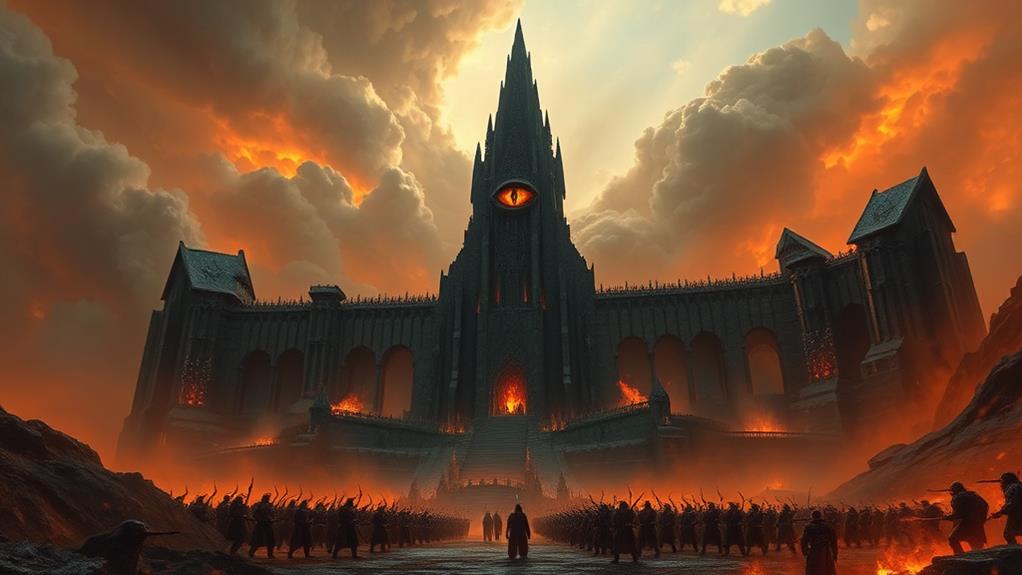
In the vast lore of Middle Earth, Sauron's dominion stands as a terrifying period marked by relentless ambition and ruthless control. You can't help but feel the weight of his imposing presence as he seeks to subjugate all free peoples under his dark rule. Sauron, the Dark Lord, master of deceit and manipulation, used the One Ring to consolidate his power, binding the other Rings of Power and their bearers to his will.
Under Sauron's regime, the lands of Mordor became a fortress of evil, teeming with orcs, trolls, and other nefarious creatures. His influence spread far and wide, corrupting leaders and sowing discord among allies. He orchestrated the fall of Númenor and played a pivotal role in the wars that swept Middle Earth. His ambitions knew no bounds, as he constantly sought to reclaim the One Ring after it was lost.
You witness his cunning in the creation of alliances, such as with Saruman, and his relentless pursuit of power, encapsulated in his dark tower, Barad-dûr. Sauron's reign symbolizes the ultimate struggle between good and evil, demonstrating the devastating impact of unchecked ambition and tyranny.
Morgoth's Reign
Before Sauron emerged as a formidable force, the Dark Lord Morgoth cast an even longer shadow over Middle Earth. You might recall that Morgoth, originally named Melkor, was the most powerful of the Ainur. His ambition and cruelty knew no bounds, and he sought to dominate all of Arda. You can trace his dark influence back to the First Age, when he corrupted many beings to serve his malevolent purposes.
Under Morgoth's reign, the lands of Beleriand suffered immensely. His fortress, Angband, became a symbol of his oppressive power. You'd see countless orcs, trolls, and other creatures of darkness marshaled to spread terror across the domains. He even corrupted the majestic Balrogs, turning them into fearsome weapons of war.
What set Morgoth apart was his ability to instill dread and despair. He didn't just conquer lands; he shattered hope. His cruelest act was the theft of the Silmarils, precious jewels crafted by Fëanor. This theft incited bloody wars and deep-seated hatred among Elves, Men, and Dwarves.
In witnessing Morgoth's reign, you'd understand the true depth of darkness that haunted Middle Earth long before Sauron took up his mantle.
Saruman's Ambition
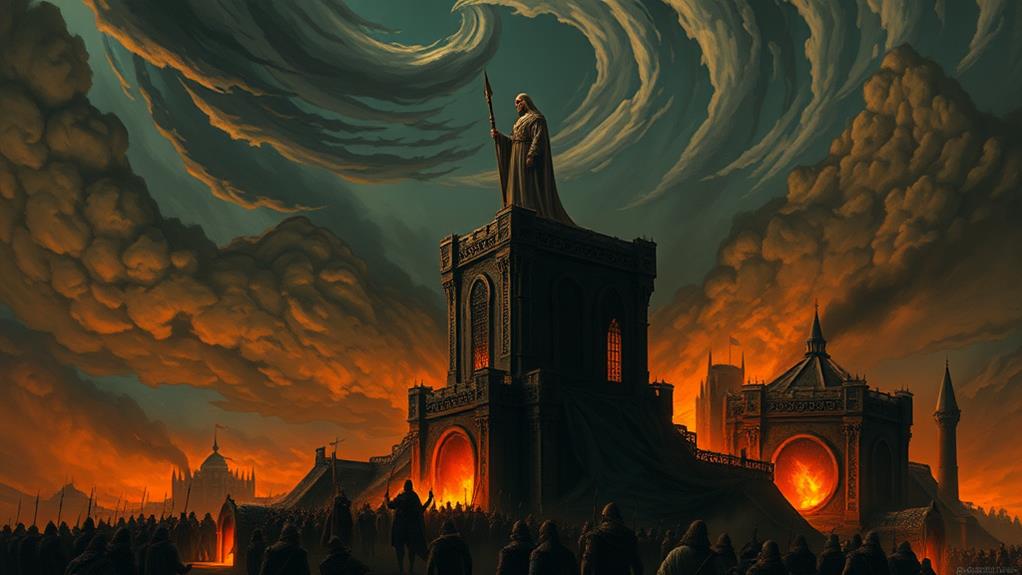
Unlike Morgoth and Sauron, Saruman's ambition was shrouded in a façade of wisdom and benevolence. You might have seen him as a guiding light, a wizard who sought to protect Middle Earth from darkness. Yet, behind those convincing words and gestures lay a heart yearning for power and control.
Saruman's strategy was subtle but insidious. He didn't declare war openly; instead, he manipulated through diplomacy and deceit. He betrayed his fellow wizards, most especially Gandalf, and allied with Sauron, hoping to seize the One Ring for himself. His stronghold in Isengard became a factory of war, churning out armies of Uruk-hai to conquer Rohan and beyond.
- Manipulation: Saruman used his voice and influence to bend others to his will.
- Deception: He feigned loyalty to the Free Peoples while plotting their downfall.
- Innovation: His creation of the Uruk-hai showed his willingness to blend dark arts with science.
You'd think a wizard of his stature would aim for nobler goals, but Saruman's lust for power led to his downfall. In the end, his ambition consumed him, leaving a legacy of betrayal and ruin.
The Witch-king's Terror
Saruman's downfall reminds us that power often comes at a steep price, and ambition can lead even the mightiest to ruin. The Witch-king of Angmar embodies this terrifying truth. As the leader of the Nazgûl, you can feel the chilling grip of fear he casts over Middle Earth. His very presence turns the bravest warriors into quivering shadows of their former selves.
Imagine standing on the battlefield of Pelennor Fields. The air is thick with tension, and suddenly, a piercing shriek echoes. The Witch-king, mounted on his fell beast, descends. You witness seasoned soldiers falter, their resolve crumbling. His powers extend beyond mere physical might; his sorcery twists the minds of his foes, spreading despair like wildfire.
He doesn't just command respect through dread; his strategic genius has toppled kingdoms. Angmar's relentless assaults devastated Arnor, an affirmation to his ruthless efficiency. His blade, imbued with dark magic, leaves wounds that never heal, a permanent reminder of his malevolent influence.
In the end, the Witch-king's terror is a haunting example of how power, when wielded with cruelty and cunning, can reshape the fate of entire domains. You can't help but shudder at the legacy he leaves behind.
Smaug's Desolation
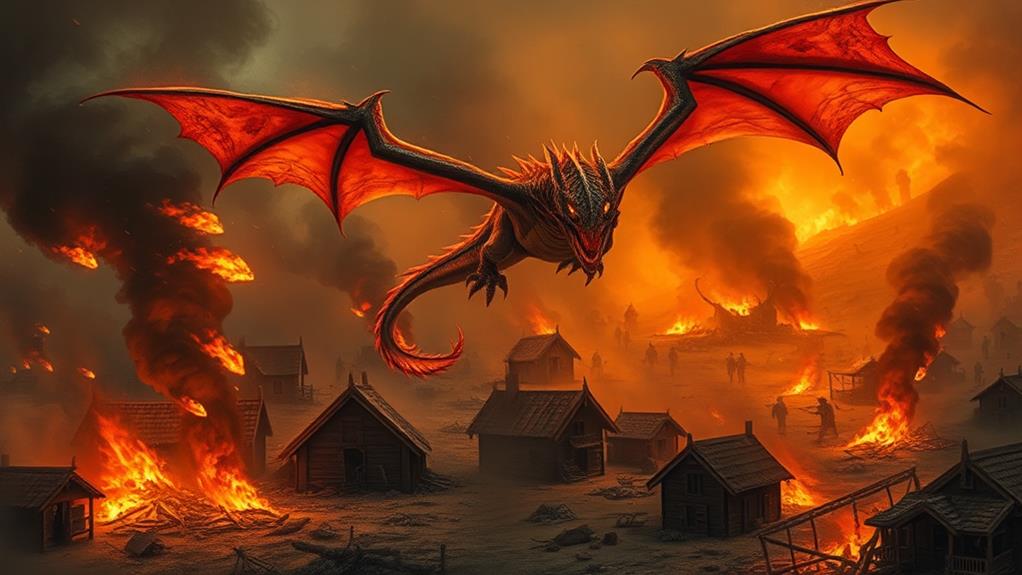
Smaug's fiery wrath is a tale etched in the annals of Middle Earth's history. As you plunge into the story, you'll find yourself captivated by the sheer destruction he wrought. Smaug, the mighty dragon, laid waste to the once-thriving Kingdom of Erebor, leaving nothing but ash and ruin in his wake. His insatiable greed for gold and jewels drove him to seize the Lonely Mountain, turning it into his lair and crushing the hopes of the Dwarves who once called it home.
Imagine standing at the foot of the mountain, feeling the heat of Smaug's breath and hearing the thunderous roar that sent shivers down the spines of even the bravest warriors. Smaug's desolation wasn't just physical; it was a psychological blow to all who knew of his terror.
Here are a few key points to draw you deeper into the legend:
- Total Devastation: Smaug obliterated entire settlements, leaving nothing but scorched earth.
- Unmatched Greed: His hoard of treasure was among the largest in Middle Earth.
- Fear Incarnate: Smaug's very name struck fear into the hearts of many.
Smaug's reign of terror remains one of the darkest chapters in Middle Earth's history.
The Fall of Númenor
Often regarded as one of the most tragic tales in Middle Earth's rich tapestry, the Fall of Númenor is a story of hubris, divine punishment, and ultimate downfall. As a reader, you're drawn into the tale of the mighty island kingdom of Númenor, blessed by the Valar with long life and unparalleled wisdom. The Númenóreans grew mighty, sailing far and wide, but their hearts turned to pride and envy, particularly of the immortal Elves.
You witness King Ar-Pharazôn, the last and mightiest king, whose ambition led him to defy the Ban of the Valar and sail to Aman, the Undying Lands, seeking immortality. This audacious act of rebellion triggered the intervention of Eru Ilúvatar, the supreme deity. With a cataclysmic upheaval, Númenor was swallowed by the sea, a divine retribution for their arrogance and defiance.
You feel the weight of their loss as the island sinks, taking with it a highly advanced civilization. Yet, a glimmer of hope survives through Elendil and his sons, who escape the cataclysm and set the stage for new chapters in Middle Earth's history. The Fall of Númenor remains a poignant reminder of the perils of unchecked ambition.
The War of the Last Alliance
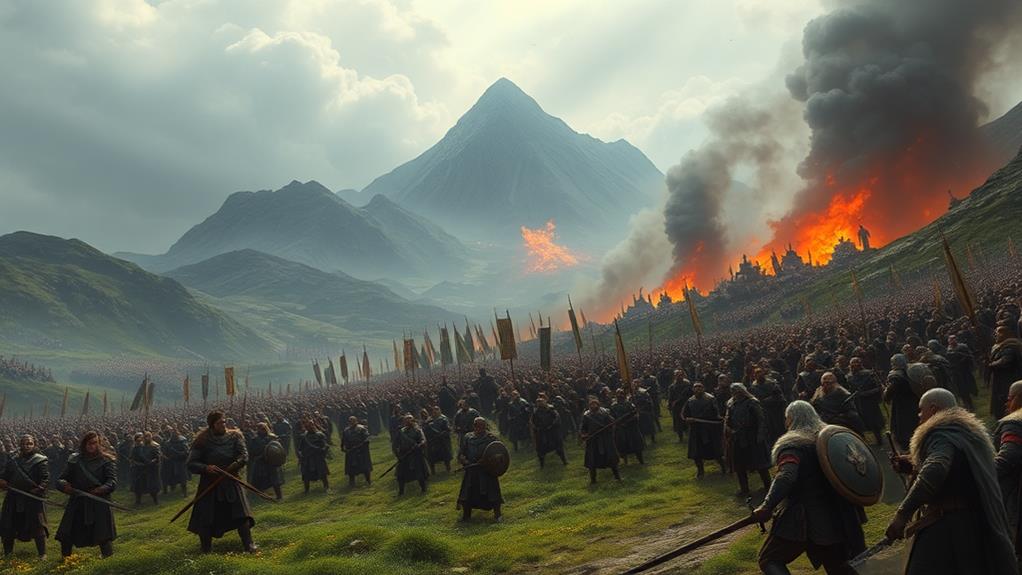
In the aftermath of Númenor's destruction, Middle Earth faced a new threat that would unite Elves and Men in a desperate stand against darkness. Sauron, having survived the cataclysm, returned to Mordor to rebuild his power. You'd find that the free peoples couldn't ignore this menace; consequently, the Last Alliance was forged.
Led by Elendil and Gil-galad, this mighty coalition marched upon Mordor, determined to end Sauron's tyranny. Imagine standing shoulder to shoulder with the greatest warriors of the age, your fate intertwined with theirs. The Alliance laid siege to Barad-dûr for seven long years, a tribute to their unwavering resolve.
The climactic battle saw Elendil and Gil-galad face Sauron directly. Though they perished, their sacrifice wasn't in vain. Isildur, Elendil's son, severed the One Ring from Sauron's hand, temporarily vanquishing him. However, Isildur's refusal to destroy the Ring sowed the seeds for future conflicts.
Key moments that will captivate you:
- Formation of the Last Alliance: Unity of Elves and Men.
- Siege of Barad-dûr: Seven years of relentless warfare.
- Sauron's Defeat: A victory marred by Isildur's fateful choice.
At a Glance
In Middle-earth's shadowed history, you see echoes of Arthurian legends and echoes of fallen empires. Each conqueror, from Sauron to Smaug, etched fear into the hearts of many, yet their reigns crumbled under the weight of their own hubris. As you reflect on these tales, remember that even the mightiest can fall. Just as Arthur's Camelot had its end, so too did these dark dominions, leaving behind lessons of courage and hope for future generations.






